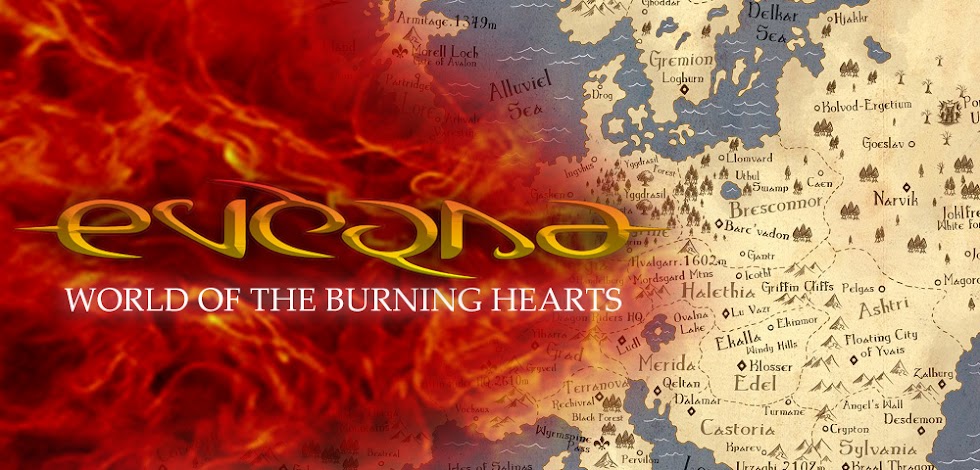To Everna and Beyond!
The official blog and novelblog for Evernade Saga and FireHeart Saga by Andry Chang
"Come forth, Paladins! Fulfill your destiny!"
Explore Worlds in Clicks
Sunday, January 28, 2007
FireHeart Threads in Internet Forums!
Speculative Vision Forum
http://speculativevision.com/forums/viewtopic.php?t=2018
PencilJack Forum
http://www.penciljack.com/forum/showthread.php?t=71912
DigitalWebbing Forum
http://www.digitalwebbing.com/forums/showthread.php?p=1078633
And some links to some blogs (forum-related, maybe) :
http://firstfolio.blogspot.com/
http://www.realsexedfacts.com/
Friday, January 26, 2007
3.2.8.2. Genilda's Advice Part 1

Early the next day, Robert and his friends are walking on the plains, out of the Jigdha’uthul swamp, heading south. From Chris and Carolyn’s faces, we know at once that they’re still fatigued and sleepy due to lack of sleep. Andreas is rather tired too but his chubby face and thick beard hide his expression and make him look as though he’s smiling.
But even Iris, the most vibrant of them all, is the first one who throws her complaint.
‘Tell me one thing, Robert. You mean you asked us to abandon the Uthul frog job and go on a dubious mission because some dragon asked for your favor in your dream?’
‘Yes, that’s so,’ says Robert, ‘and she’s not some dragon. She’s Algaban, the most ancient of dragons in our world and age!’
Andreas adds, ‘We know about Algaban, Robert. But we still can’t trust her until we actually meet her.’
Carolyn also adds, ‘Maybe she’s an impostor, trying to lure you into a trap.’
Robert answers calmly, ‘Yes, I’ve thought of that too, but I’ve decided to help her. So, in a way or another, we go to Mount Hvalgarr. All I ask of you is to get prepared for anything. If she’s indeed an impostor, we’ll kill her. And if it’s a trap we’ll clear it up so no one else will fall into the same trap like we do.’
‘Aye, that’s very noble of you, lad,’ says Andreas. ‘But I feel we’ll be fighting forces beyond our comprehension!’
‘Didn’t we always?’ says Robert, ‘in our jobs, missions, in Enia’s Sanctum?’
‘And it’s worth dropping other jobs… even going home,’ says Chris. Carolyn stares at Chris with worry. Chris looks totally messed up, exhausted from sleepless nights. Carolyn says,
‘You said Algaban asked us to be on her side in a week, isn’t it? I suggest we better fetch our horses now, and return to Barc’vadon to rest and resupply. It’ll only take two days, max. And then we’ll ride all the way to Hvalgarr so we can reach Algaban in time.’
‘Sounds like a good plan,’ says Iris.
Robert looks at his friends one by one, and concludes,
‘I’m glad we are all agreed to this. Now let us hurry, we much reach the stables before sundown.’
==oOo==
As evening comes the next day, the streets in Barc’vadon, the capital of the Kingdom of Bresconnor are dark – except the dim candle lights from the houses and buildings there. It’s a grim city, no doubt about that, with grim-faced, rude people living there. Most of the buildings are shabby and some of them are even beyond repair and in the brink of collapse.
Many said the condition in this ‘grim slum city’ is the outcome from a nation ruled by corrupt, tyrant nobles and an incompetent king, Chivron van Kreulen. Because of high taxes and lack of resources, the people of Bresconnor only want to survive. They don’t give a damn whatsoever about honor, justice, aesthetics and the good of the society. They are nothing but selfish, dumb and violent brutes, the exact contrary with the lavish landlords.
But of course, not all peasants there are brutes, and not all nobles are corruptors. There are still a few nobles who are really noble, and parts of the population are good, hard-working people who uphold justice, decency and honor above anything else, like our friend here, Yemima Genilda.
Genilda, a widow in her forties, plain but cheerful looking, is standing in front of her flower shop, the tidiest house in her block. The streets in this block are practically deserted now. Genilda looks around and sighs.
‘Jolly holly, looks like we will be together again one more day,’ Genilda speaks to her flowers as though they are her own family.
Then she hums melodiously, humming some Bresconian folk songs and enjoying her work, watering the flowers and shoveling the earth around them to make it loose. Tulips (only found in Bresconnor), roses, dandelions, and various sorts of flower plants native to Aurelian Continent are neatly and orderly kept in big vases in the front of the shop. Butterflies are sometimes seen flying around them, supplements of the beautiful scenery. Thanks to Genilda’s care, the flowers in this shop are always fresh and somewhat radiant, like their counterparts in the wild.
Genilda sighs a bit while humming, thinking. What use are pretty fresh flowers if no one’s buying them? No one cares about beauty here anymore. Even a man only presents bread to propose to the girl he loves. If I don’t love my flowers, I’ll abandon them and move to Lore for my kids’ sake. But thanks to my friends, I now have extra income for a year and a half now; it can cover up all my expenses including taking care of my flowers. And I don’t have to go adventuring again – after the loss of my honey hubby, Kluyvard.
Kluyvard’s widow pauses for a while, thinking back about what happened in Enia’s Sanctum. After a brief moment, suddenly Enia is snapped back to herself. Well, my job is done, and I’ll call it a day then...
But wait! I think I see people coming from there. Ah, yes! It’s them, all right.
The friends whom Genilda referred to are Robert, Chris, Carolyn, Iris and Andreas, the party of five. They are walking towards Genilda’s shop in a hurry. Genilda greets them, saying,
‘Rob, guys, glad to see you back safe and sound. What’s taking you in such a hurry?’
‘We have an urgent thing coming. We’ll talk inside,’ says Robert.
‘After supper, I suppose,’ says Chris. ‘Man, I’m so hungry I can eat a whole cow!’
Sponsor:
Quality and Affordable Sound Systems and Car Audio, Jakarta
Phone: (62-21) 6397361
3.2.8.2. Genilda's Advice Part 2
The act soon finishes, the girls bow to the dolls, and the hunters give them a hearty applause. Chiel also does somersaults in mid-air happily.
‘Beautiful, girls. So well done,’ says Andreas.
‘Lauryn, Marjan, that’s a good one, girls, but you better help out in the kitchen now. It’s almost dinner and Uncle Chris is famished.’
‘Aw, mom, do we have to?’ says Marjan.
‘Mom must work now, sweethearts. Don’t argue with me or we all won’t have dinner tonight.’
‘Oh, awright...’
Marjan’s elder sister, Lauryn goes straight into the kitchen without saying a word. From the look of her face, we can say that Lauryn doesn’t like too many people (strangers in particular) staying in her house, even for a few hours.
Genilda then takes the hunters into another room. This room looks like an office or a meeting room, and piles of documents are sorted neatly, categorically and alphabetically on the racks. Scent of chamomile comes from the vases kept on the walls, on the left and right side of the windowless room. It’s a typical, well-organized office run by women.
But one can judge by a few posters pinned on a wooden board on the wall that it’s not an ordinary office. And if we see the posters more clearly: wanted criminals, monsters to hunt, items and treasures on demand, we can obviously conclude that it’s a hunters’ guild.
Genilda takes her seat, and after her guests are well-seated (except Robert, who in his nature prefers standing this time) begins talking casually but inquiringly.
‘So, what’s the big hurry, guys? You can’t wait to cash the goods in, can you? I didn’t expect you to get the Uthul frog galls so quickly.’
Carolyn answers sheepishly, ‘Er, actually... we didn’t bring ALL of them. We didn’t complete the task.’
‘Yeah,’ says Iris, ‘something just came up.’
‘Jolly holly! What kept you? What made you end your spotless record? Well, whatever it is, it better be good.’
Robert answers, ‘Now listen to me and I’ll tell you everything. You see, Genilda...’
Robert goes on, telling Genilda about his dream and everything he has told his comrades. Genilda listens patiently with full attention and only comments when Robert finishes his explanation.
‘So, you abandoned your task to follow a vision, a mission given in your dream?’
‘Yes, I am. I too doubted her at first, just like you to me now. But after she showed me so many things and even explained about her weakness, I have no other thought but to go there and find out either it is real or a trap. Whatever we do, we are ready and we’ll see it through to the end for the sake of mankind.’
‘Good thinking, Rob. But let me get this straight. You’ll be risking your necks out there just like Enia’s Sanctum and this time there are going to be only five of you. Are you sure you don’t want to bring anybody else there? I mean, “ancient dragons” can be absolutely, infinitely nasty, you know.’
‘I appreciate your concern, Ilda. But I think we made quite an improvement since Sanctum, from our jobs and journeys around Aurelia. We have experienced much, if not, Algaban wouldn’t have called us.’
‘Well, no point stopping you then, if you are so confident about your team. I’ll help provide for your provisions and tell you the quickest way to Mount Hvalgarr. But let me analyze the situation first. I believe you told me that Algaban has given eight weapons away from the arsenal. Deathscythe Crow, Terra Nakroß, Deathblade Kraal’shazar, Chrono Chakram, Colathaloc, Viper Cane, Carrion Halberd and the daggers stained with cursed blood: Ultimatum.’
‘Right.’
‘Kraal’shazar is in Adler’s hand now. He is still the prime suspect for being Vordac’s real new host, and is watched closely by his partners, Eidos Crydias – the holder of Chrono Chakram and Hernan Parvaez. But judging from his behavior until now, I think Vordac’s spirit is still weak and dormant, hiding somewhere or is still sealed in the sword, or perished with Paliades. Alexis holds the Colath’aloc, Desmond the Terra Nakroß, and the Ultimatum, you know who owns them... the rogue assassin MacLair – he is still at large, the most wanted man in Aurelia. I don’t know where the Crow Scythe and Carrion Halberd are now.
That leaves the Viper Cane. Do you know who owns it?’
‘I don’t know, Ilda. And neither do the rest of us.’
Carolyn cuts in, ‘Ilda, from the sound of your voice, you do know who the owner is, right? I mean, I thought the Viper Cane was lost for ages!’
‘You’re right, Carol,’ answers Genilda, ‘I know who’s the new master of the Viper Cane. She is called Zal’fira, a native Bresconnor. She once was a dark witch with no repute, until she took up necromancy. No one knows when and where she found that cursed cane, but it only took her five years to perfect her necromancy crafts. And one more thing, I heard she made a spiritual bond with the ancient dark dragon, Omegron the Tiamat, and she has sold her soul to Sodomos. The reason why you never heard of her is she never did anything big until now. All she does are experiments, with corpses, poisons and alchemy, and she meditates a lot.
With Omegron on her side, she now possesses one of the mightiest forces in Aurelia. Beside Sylvanian dark forces, Zal’fira is most likely one of the “great forces” Algaban fears. I tell you this so you’ll be prepared for anything lies ahead. Remember, if you must fight Zal’fira, be extremely careful. Well-known enemies of their well-known methods – like MacLair, for instance – are easier to fight against. But this Zal’fira... it’ll be extremely harder to fight someone you hardly know about.’
‘But how do you know her?’ says Iris. ‘You said even Bresconians hardly heard of her.’
‘That’s because we used to hunt together as a party when we were young. She is five years older than I am, yet I used to save her life so many times that she harbored envy towards me. Her envy turned into hate when I and Kluyvard were married. She liked ol’ Kluy, you know. She left our hunting party without a word and didn’t come to our wedding party either. I didn’t hate her because of that, but I never expected her to be this terrible.’
Chris concludes, ‘So, in other words, we must prepare to fight against the heir or the heir’s minions, Zal’fira, or plus Algaban herself.’
‘Yup.’
‘And the chance of us getting out of Hvalgarr Mountain cave alive is as thin as a strand of hair split in half.’
‘You said it.’
‘Bring them on.’
‘We have promised, so we’ll go as soon as possible,’ says Robert. ‘Thank you for your invaluable information, Ilda. I really appreciate it.’
Genilda answers with a slight remorse. ‘Jolly holly, I knew from the start that I can’t always depend on you guys as my meal ticket. I knew you’ll go far away again, only this time I fear that I won’t be seeing you again for a long, long time.’
Carolyn responds, a bit concerned. ‘Aw, Ilda, don’t be like that. I know we will meet again soon. But what will you do without us?’
‘Don’t worry about me, my friends,’ says Genilda. ‘When I decided to open this secret guild, I planned ahead to make this guild grow. Hunter guilds are illegal in Bresconnor, but with the flower shop as camouflage, I managed to assign several good hunters to do the tasks. There are fourteen of them active now. They are never as good as or better than you guys, but they proved to be a great help with a good rate of job completions. So, go. I and my kids will be okay.’
‘I’m sure you will, Ilda,’ says Carolyn with the sweetest smile she can put on. ‘You have been so resourceful since the first time we met you. I’m sure you’ll be all right.’
Genilda smiles back at Carolyn, saying, ‘Well, in that case let us dine, prepare and pray, may Vadis take care of you in your mission. Now what took the kids...’
GRUMBLE!
‘Hey, what’s that?’ says Iris, puzzled.
GRRRUMBLEEE!
Iris and the others look around to find the source of the grumbling sound. As they see Christopher rubbing his stomach with his two hands with a grimace on his face, they know at once that the sounds were from Chris’ empty stomach. Instead of being sympathetic to Chris, they all – except Robert – laugh out very-very loudly, amused with Chris’ attitude.
Robert shakes his head slightly with his ever-serious face. And Chris, of course, feels so ashamed in addition of his hunger. His face blushes like a little kid and he rushes out from the room towards the kitchen, under his friends’ continuous laughter.
Monday, January 22, 2007
Sang Penandai - The Taleweaver
- The Loreweaver's Advice
Indonesian Language - Review, Study, Research
Click on link to view (or buy) the book
Judul Sang Penandai
No. ISBN 979-1112-31-2
Penulis Tere Liye
Penerbit Serambi
Tanggal terbit Januari - 2007
Jumlah Halaman 366
Jenis Cover Soft Cover
Dimensi(L x P) 130x200mm
Kategori Fantasi
Text Bahasa Indonesia
SINOPSIS BUKU
Terbayangkah Anda, seorang anak manusia melarung kenangan-pahit cinta dengan menyusuri puluhan ribu mil samudera selama lebih dari 1513 hari? Jim, seorang pemain biola, tertikam sesal mendalam karena kehilangan Nayla. Dia selalu gagal melupakan kepengecutan membayar janji kepada gadis pujaannya itu. Dalam selubung rasa putus asa, bersalah, dan tak berharga sebagai lelaki, bertemulah Jim dengan Sang Penandai, pembuat dan penjaga dongeng-dongeng.
Dia pun terpandu melaut ke negeri-negeri Timur. Bersama Armada Kota Terapung di bawah pimpinan Laksamana Ramirez, Jim yatim-paitu yang dibesarkan oleh dermawan kota, si miskin-papa yang hanya pintar memainkan biola, pemuda yang terlalu pengecut untuk melawan takdir hidupnya-mengubah diri menjadi sosok penting dalam ekspedisi ke Tanah Harapan. Bertempur dengan para perompak legenda perbatasan benua, singgah dan mendaki lereng Puncak Adam, dan menjadi pahlawan dalam perang saudara di negeri Champa, semua dia lalui sembari bergulat dengan hantu masa lalunya. Di ujung kisah, Jim menamatkan pelajaran berharga tentang "menjadi pencinta sejati" dan "berdamai dengan masa lalu".***
"Saya seumur-umur belum pernah membaca novel sampai habis. Novel yang menakjubkan!! Jim menggambarkan sosok yang tak kunjung selesai mencari jati diri dan juga hakikat cinta. Sang "Penandai", yang dijadikan penulis sebagai tokoh imaginer, menjadi simbol moral yang membimbing Jim mengarungi kehidupan yang nyaris tak bertepi. Sementara Nayla melambangkan sosok ideal yang memang hanya bisa kita gapai dalam mimpi. Sungguh, novel ini sangat menyenangkan hingga ke akhir cerita, jauh dari membosankan, dan tidak cengeng."-- FAISAL BASRI, Pengamat Ekonomi-Politik
"Sebuah novel fantasi tentang perjalan pencarian jati diri yang berliku. Layak dinikmati."-- HABIBURRAHMAN EL SHIRAZY, Penulis Ayat-ayat Cinta
"Membaca novel ini, pembaca harus siap-siap memasuki sebuah dunia fantasi, dikuasai oleh panorama samudra. Gerakannya kolosal, tidak merujuk pada pilar sejarah dan geografi yang eksak, dengan flot tak terduga. Ribuan capung, Sang Penandai yang tak kenal masa dan cinta Nayla-semuanya kita terima sebagai pelangi fantasi banyak-warna novelis Tere Liye."-- TAUFIK ISMAIL, Penyair
Sunday, January 21, 2007
Accell's FireHeart Cellphone Wallpapers! - Art
Categories : Art, Characters, Fireheart
FireHeart Wallpapers for Nokia and Sony Ericsson Phones Art
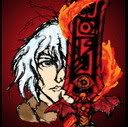
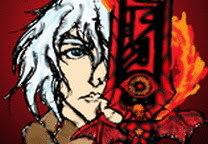
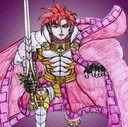
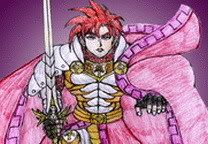
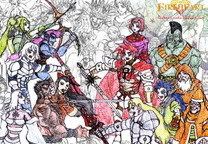
And some more bonuses (various wallpapers) for you!
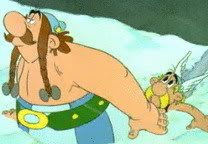
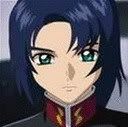
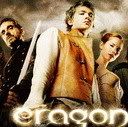
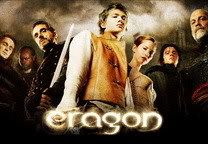
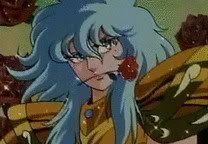
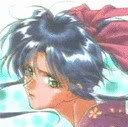
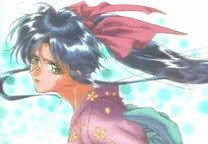

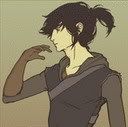
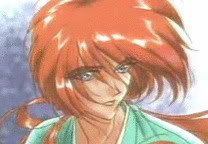

Sorry for the irrelevancies, and enjoy!
Aurelia Continent Map - Update 02 - Art
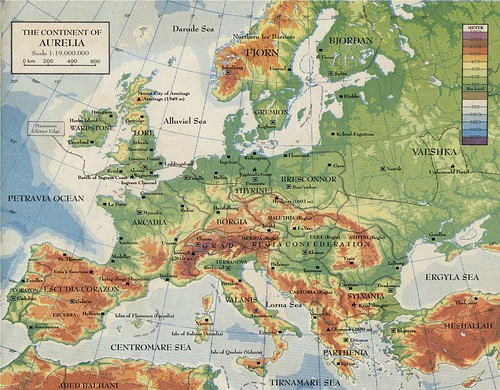
Hi, this is the 2nd impression of the Aurelia Continent Map - the settings for FireHeart Saga.
Want to add names for lakes, cities, rivers etc? Just name it in the comment (and some details if you like). I'd be very, very grateful. - BJ Vadis
Note : I must've put Swanson River next to Alceste. It's in the story.
Categories: Art, Eternia, Fireheart, Study
Friday, January 19, 2007
Elf - a Study
From Wikipedia, the free encyclopedia
Jump to: navigation, search
For other uses, see Elf (disambiguation).

An elf is a mythical creature of Germanic mythology and Germanic paganism which still survives in northern European folklore. In Norse mythology they were originally a race of minor gods of nature and fertility. Elves are often pictured as youthful-seeming men and women of great beauty living in forests and other natural places, underground, or in wells and springs. They have been portrayed to be long-lived or immortal and they have magical powers attributed to them. Following the success of J. R. R. Tolkien's epic work The Lord of the Rings—wherein a wise, angelic people named Elves play a significant role—they have become staple characters of modern fantasy (see: Elves in fantasy fiction and games).
Elf can be pluralised both as elves and elfs. Something associated with elves or the qualities of elves is described by the adjectives elven, elvish, elfin or elfish. A convention of modern fantasy usage is: the v in elven or elvish refers to human-sized elves (who correspond more closely to the mythology of the Viking Era), whereas the f in elfin or elfish refers to tiny-sized elfs (who correspond more closely to the folklore of the Renaissance and Romantic Eras). They are also called:
Germany: Elfen, Elben, Alben (the last one was used by Richard Wagner)
Great Britain: addler (obsolete)
Netherlands: elfen, elven, alven
Denmark: alfer, elvere, elverfolk, ellefolk or huldrer.
Iceland: álfar, álfafólk and huldufólk (hidden people)
Norway: alver, alfer or elvefolk
Sweden: alfer, alver or älvor (Älvor translates to fairies)
After much debate, the consensus is elf, álf and related words derive from the Proto-Indo-European root *albh meaning "white", whence also the Latin albus "white", whence Portuguese, Spanish and English albino.[1][2]
Contents[hide]
1 Elves in Norse mythology
2 Scandinavian elves
3 German elves
4 English elves
5 Modern elves
5.1 Elves at Christmas
5.2 Elves in modern fantasy
5.3 Elves in psychedelic experience
6 References
7 See also
//
[edit] Elves in Norse mythology
The earliest preserved description of elves comes from Norse mythology. In Old Norse they are called álfar (singular, nominative case: álfr), and although no older or contemporary descriptions exist, the appearance of beings etymologically related to álfar in various later folklore strongly suggests that the belief in elves was common among all the Germanic tribes, and not limited solely to the ancient Scandinavians.
Elves make various appearances in Norse mythology. Although the concept itself is never clearly defined in our sources, elves appear to have been understood as powerful and beautiful human-sized beings. They are commonly referred to collectively as semi-divine beings associated with fertility as well as the cult of the ancestors. As such, elves appear similar to the animistic belief in spirits of nature and of the deceased, common to nearly all human religions; something that, on a side note, is true also for the Old Norse belief in fylgjur and vörðar ("follower" and "warden" spirits, respectively). Arguably, elves are the Germanic equivalent to the nymphs of Greek and Roman mythology, as well as the vili and rusalki of Slavic mythology.

The god Freyr, the lord of the light-elves
The Icelandic mythographer and historian Snorri Sturluson referred to dwarves (dvergar) as "dark-elves" (dökkálfar) or "black-elves" (svartálfar); whether this usage reflects wider medieval Scandinavian belief is uncertain.[3] Elves who are not dark-elves are referred to by Snorri as "light-elves" (ljósálfar); this usage has often been connected with elves' etymological connection with whiteness. Snorri describes their differences like so (Gylfaginning 17, Prose Edda):
"There is one place there [in the sky] that is called the Elf Home (Álfheimr). People live there that are named the light elves (ljósálfar). But the dark elves (dökkálfar) live below in earth, and they are unlike them in appearance – and more unlike them in reality. The Light Elves are brighter than the sun in appearance, but the Dark Elves are blacker than pitch."
"Sá er einn staðr þar, er kallaðr er Álfheimr. Þar byggvir fólk þat, er Ljósálfar heita, en Dökkálfar búa niðri í jörðu, ok eru þeir ólíkir þeim sýnum ok miklu ólíkari reyndum. Ljósálfar eru fegri en sól sýnum, en Dökkálfar eru svartari en bik." [4]
Evidence for elves in Norse mythology outside Snorri's work, and in earlier evidence, comes from Skaldic poetry, the Poetic Edda and legendary sagas. Here elves are linked with the Æsir, particularly through the common phrase "Æsir and the elves", which presumably means "all the gods".[5] The elves have been compared or identified with the Vanir (fertility gods) by some scholars.[6] However, in the Alvíssmál ("The Sayings of All-Wise"), the elves are considered distinct from both the Vanir and the Æsir, as revealed by a series of comparative names in which Æsir, Vanir, and elves are given their own versions for various words in a reflection of their individual racial preferences. Possibly, the words designate a difference in status between the major fertility gods (the Vanir) and the minor ones (the elves). Grímnismál relates that the Van Freyr was the lord of Álfheimr (meaning "elf-world"), the home of the light-elves. Lokasenna relates that a large group of Æsir and elves had assembled at Ægir's court for a banquet. Several minor forces, the servants of gods, are presented such as Byggvir and Beyla, who belonged to Freyr, the lord of the elves, and they were probably elves, since they were not counted among the gods. Two other mentioned servants were Fimafeng (who was murdered by Loki) and Eldir.
Some speculate that Vanir and elves belong to an earlier Nordic Bronze Age religion of Scandinavia, and were later replaced by the Æsir as main gods. Others (most notably Georges Dumézil) argue that the Vanir were the gods of the common Norsemen, and the Æsir those of the priest and warrior castes (see also Nerthus).
A poem from around 1020, the Austrfaravísur ('Eastern-journey verses') of Sigvatr Þorðarson, mentions that, as a Christian, he was refused board in a heathen household, in Sweden, because an álfablót ("elves' sacrifice") was being conducted there. However, we have no further reliable information as to what an álfablót involved,[7] but like other blóts it probably included the offering of foods, and later Scandinavian folklore retained a tradition of sacrificing treats to the elves (see below). From the time of year (close to the autumnal equinox) and the elves' association with fertility and the ancestors, we might assume that it had to do with the ancestor cult and the life force of the family.

The smith hero Völundr, the ruler of the dökkálfar (dark-elves)
In addition to this, Kormáks saga accounts for how a sacrifice to elves was apparently believed able to heal a severe battle wound:
Þorvarð healed but slowly; and when he could get on his feet he went to see Þorðís, and asked her what was best to help his healing.
"A hill there is," answered she, "not far away from here, where elves have their haunt. Now get you the bull that Kormák killed, and redden the outer side of the hill with its blood, and make a feast for the elves with its flesh. Then thou wilt be healed."[8]
The Scandinavian elves were of human size. Full-sized famous men could be elevated to the rank of elves after death, such as the petty king Olaf Geirstad-Elf, and the smith hero Völund (titled as "ruler of elves" in the Völundarkviða). Even crossbreeding was possible between elves and humans in the Old Norse belief. One case appears in Hrólf Kraki's saga, where the Danish king Helgi finds an elf-woman clad in silk who is the most beautiful woman he has ever seen. He rapes her and later she bears the daughter Skuld, who married Hjörvard, Hrólf Kraki's killer. Since Skuld was half-elven, she was very skilled in witchcraft (seiðr), and this to the point that she was almost invincible in battle. When her warriors fell, she made them rise again to continue fighting. The only way to defeat her was to capture her before she could summon her armies, which included elvish warriors[9]. Another case was the hero Högni, whose mother was a human queen, and whose father, according to the Thidrekssaga, was an elf by the name of Aldrian (though this text is largely translated from German material).
There are also in the Heimskringla and in Þorsteins saga Víkingssonar accounts of a line of local kings who ruled over Álfheim, corresponding to the modern Swedish province Bohuslän, and since they had elven blood they were said to be more beautiful than most men.
The land governed by King Alf was called Alfheim, and all his offspring are related to the elves. They were fairer than any other people...[10]
The last king is named Gandalf.
[edit] Scandinavian elves

Little älvor, playing with Tomtebobarnen. From Children of the Forest (1910) by Swedish author and illustrator Elsa Beskow.
In Scandinavian folklore, which is a later blend of Norse mythology and elements of Christian mythology, an elf is called elver in Danish, alv in Norwegian, and alv or älva in Swedish (the first is masculine, the second feminine). The Norwegian expressions seldom appear in genuine folklore, and when they do, they are always used synonymous to huldrefolk or vetter, a category of earth-dwelling beings generally held to be more related to Norse dwarves than elves which is comparable to the Icelandic huldufólk (hidden people).
In Denmark and Sweden, the elves appear as beings distinct from the vetter, even though the border between them is diffuse. The insect-winged fairies in the folklore of the British Isles are often called "älvor" in modern Swedish or "alfer" in Danish, although the correct translation is "feer." In a similar vein, the alf found in the fairy tale The Elf of the Rose by Danish author H. C. Andersen is so tiny that he can have a rose blossom for home, and has "wings that reached from his shoulders to his feet". Yet, Andersen also wrote about elvere in The Elfin Hill. The elves in this story are more alike those of traditional Danish folklore, who were beautiful females, living in hills and boulders, capable of dancing a man to death. Like the huldra in Norway and Sweden, they are hollow when seen from the back. The elves of Norse mythology have survived into folklore mainly as females, living in hills and mounds of stones[11] (cf. Galadriel's account of what would happen to the Elves who remained in Middle-earth). The Swedish älvor[12] (sing. älva) were stunningly beautiful girls who lived in the forest with an elven king. They were long-lived and light-hearted in nature. The elves are typically pictured as fair-haired, white-clad and like most creatures in the Scandinavian folklore can be really nasty when offended. In the stories, they often play the role of disease-spirits. The most common, though also most harmless case was various irritating skin rashes, which were called älvablåst (elven blow) and could be cured by a forceful counter-blow (a handy pair of bellows was most useful for this purpose). Skålgropar, a particular kind of petroglyph found in Scandinavia, were known in older times as älvkvarnar (elven mills), pointing to their believed usage. One could appease the elves by offering them a treat (preferably butter) placed into an elven mill – perhaps a custom with roots in the Old Norse álfablót.
Ängsälvor, "meadow elves", (1850), painting by Nils Blommér.
The elves could be seen dancing over meadows, particularly at night and on misty mornings. They left a kind of circle where they had danced, which were called älvdanser (elf dances) or älvringar (elf circles), and to urinate in one was thought to cause venereal diseases. Typically, it consisted of a ring of small mushrooms, but there was also another kind of elf circle:
On lake shores, where the forest met the lake, you could find elf circles. They were round places where the grass had been flattened like a floor. Elves had danced there. By Lake Tisaren,[13] I have seen one of those. It could be dangerous and one could become ill if one had trodden over such a place or if one destroyed anything there.[11]
If a human watched the dance of the elves, he would discover that even though only a few hours seemed to have passed, many years had passed in the real world. (This time phenomenon is retold in Tolkien's The Lord of the Rings when the Fellowship of the Ring discovers that time seems to have run more slowly in elven Lothlórien. It also has a remote parallel in the Irish sídhe.) In a song from the late Middle Ages about Olaf Liljekrans, the elven queen invites him to dance. He refuses, he knows what will happen if he joins the dance and he is on his way home to his own wedding. The queen offers him gifts, but he declines. She threatens to kill him if he does not join, but he rides off and dies of the disease she sent upon him, and his young bride dies of a broken heart.[14]
However, the elves were not exclusively young and beautiful. In the Swedish folktale Little Rosa and Long Leda, an elvish woman (älvakvinna) arrives in the end and saves the heroine, Little Rose, on condition that the king's cattle no longer graze on her hill. She is described as an old woman and by her aspect people saw that she belonged to the subterraneans.[15]
[edit] German elves
What remained of the belief in elves in German folklore was that they were mischievous pranksters that could cause disease to cattle and people, and bring bad dreams to sleepers. The German word for nightmare, Albtraum, means "elf dream". The archaic form Albdruck means "elf pressure"; it was believed that nightmares are a result of an elf sitting on the dreamer's head. This aspect of German elf-belief largely corresponds to the Scandinavian belief in the mara. It is also similar to the legends regarding incubi and succubi.[16]
As noted above, an elven king occasionally appears among the predominantly female elves in Denmark and Sweden. In the German middle-age epic the Nibelungenlied, a dwarf named Alberich play an important role. Alberich literally translates as "elf-sovereign", further contributing to the elf–dwarf confusion observed already in the Younger Edda. Via the French Alberon, the same name has entered English as Oberon – king of elves and fairies in Shakespeare's A Midsummer Night's Dream (see below).
The legend of Der Erlkönig appears to have originated in fairly recent times in Denmark and Goethe based his poem on "Erlkönigs Tochter" ("Erlkönig's Daughter"), a Danish work translated into German by Johann Gottfried Herder.
The Erlkönig's nature has been the subject of some debate. The name translates literally from the German as "Alder King" rather than its common English translation, "Elf King" (which would be rendered as Elfenkönig in German). It has often been suggested that Erlkönig is a mistranslation from the original Danish elverkonge or elverkonge, which does mean "elf king".
According to German and Danish folklore, the Erlkönig appears as an omen of death, much like the banshee in Irish mythology. Unlike the banshee, however, the Erlkönig will appear only to the person about to die. His form and expression also tell the person what sort of death they will have: a pained expression means a painful death, a peaceful expression means a peaceful death. This aspect of the legend was immortalised by Goethe in his poem Der Erlkönig, later set to music by Schubert.
In the Brothers Grimm fairy tale Der Schuhmacher und die Heinzelmännchen, a group of naked, one foot tall beings called Heinzelmännchen help a shoemaker in his work. When he rewards their work with little clothes, they are so delighted, that they run away and are never seen again. Even though Heinzelmännchen are akin to beings such as kobolds and dwarves, the tale has been translated to English as The Shoemaker & the Elves, (probably due to the similarity of the henzelmannchen to Scottish brownies) and is echoed in J. K. Rowling's Harry Potter stories (see House-elf).
[edit] English elves

Poor little birdie teased, by Victorian era illustrator Richard Doyle depicts the traditional view of an elf from later English folklore as a diminutive woodland humanoid.
The word elf came into English as the Old English word ælf (pl. ælfe, with regional and chronological variants such as ylfe and ælfen), and so came to Britain originally with the Anglo-Saxons.[17] Words for the nymphs of the Greek and Roman mythos were translated by Anglo-Saxon scholars with ælf and variants on it.[18]
Although our early English evidence is slight, there are reasons to think that Anglo-Saxon elves (ælfe) were similar to early elves in Norse mythology: human-like, human-sized supernatural beings, predominantly if not exclusively male, capable of helping or harming the people who encountered them. In particular, the pairing of æsir and álfar found in the Poetic Edda is mirrored in the Old English charm Wið færstice and in the distinctive occurrence of the cognate words os and ælf in Anglo-Saxon personal names (e.g. Oswald, Ælfric[19]).
In relation to the beauty of the Norse elves, some further evidence is given by old English words such as ælfsciene ("elf-beautiful"), used of seductively beautiful Biblical women in the Old English poems Judith and Genesis A.[20] Although elves could be considered to be beautiful and potentially helpful beings in some sections of English-speaking society throughout its history, Anglo-Saxon evidence also attests to alignments of elves with demons, as for example in line 112 of Beowulf. On the other hand, oaf is simply a variant of the word elf, presumably originally referring to a changeling or to someone stupefied by elvish enchantment.
Elf-shot (or elf-bolt or elf-arrow) is a word found in Scotland and Northern England, first attested in a manuscript of about the last quarter of the 16th century. Although first attested in the sense 'sharp pain caused by elves', it is later attested denoting Neolithic flint arrow-heads, which by the 17th century seem to have been attributed in Scotland to elvish folk, and which were used in healing rituals, and alleged to be used by witches (and perhaps elves) to injure people and cattle.[21] So too a tangle in the hair was called an elf-lock, as being caused by the mischief of the elves, and sudden paralysis was sometimes attributed to elf-stroke. Compare with the following excerpt from an 1750 ode by Willam Collins:
There every herd, by sad experience, knows
How, winged with fate, their elf-shot arrows fly,
When the sick ewe her summer food forgoes,
Or, stretched on earth, the heart-smit heifers lie.[22]
The elf makes many appearances in ballads of English and Scottish origin, as well as folk tales, many involving trips to Elphame or Elfland (the Álfheim of Norse mythology), a mystical realm which is sometimes an eerie and unpleasant place. The elf is occasionally portrayed in a positive light, such as the Queen of Elphame in the ballad Thomas the Rhymer, but many examples exist of elves of sinister character, frequently bent on rape and murder, as in the Tale of Childe Rowland, or the ballad Lady Isabel and the Elf-Knight, in which the Elf-Knight bears away Isabel to murder her. Most instances of elves in ballads are male; the only commonly encountered female elf is the Queen of Elfland, who appears in Thomas the Rhymer and The Queen of Elfland's Nourice, in which a woman is abducted to be a wet-nurse to the queen's baby, but promised that she may return home once the child is weaned. In none of these cases is the elf a spritely character with pixie-like qualities.
English folktales of the early modern period typically portray elves as small, elusive people with mischievous personalities. They are not evil but might annoy humans or interfere in their affairs. They are sometimes said to be invisible. In this tradition, elves became more or less synonymous with the fairies that originated from native British mythology, for example, the Welsh Ellyll (plural Ellyllon) and Y Dynon Bach Têg. Lompa Lompa the Gigantic Elf from Plemurian Forest.

"To make my small elves coats; and some keep back." One of Arthur Rackham's illustrations to William Shakespeare's A Midsummer Night's Dream.[23]
Successively, the word elf, as well as literary term fairy, evolved to a general denotation of various nature spirits like pwcca, hobgoblin, Robin Goodfellow, the Scots brownie, and so forth. These terms, like their relatives in other European languages, are no longer clearly distinguished in popular folklore.
Significant for the distancing of the concept of elves from its mythological origins was the influence from literature. In Elizabethan England, William Shakespeare imagined elves as little people. He apparently considered elves and fairies to be the same race. In Henry IV, part 1, act II, scene iv, he has Falstaff call Prince Henry, "you starveling, you elfskin!", and in his A Midsummer Night's Dream, his elves are almost as small as insects. On the other hand, Edmund Spenser applies elf to full-sized beings in The Faerie Queene.
The influence of Shakespeare and Michael Drayton made the use of elf and fairy for very small beings the norm. In Victorian literature, elves usually appeared in illustrations as tiny men and women with pointed ears and stocking caps. An example is Andrew Lang's fairy tale Princess Nobody (1884), illustrated by Richard Doyle, where fairies are tiny people with butterfly wings, whereas elves are tiny people with red stocking caps. There were exceptions to this rule however, such as the full-sized elves who appear in Lord Dunsany's The King of Elfland's Daughter.
There is a legend concerning the Buckthorn vows that if one sprinkles Buckthorn in a circle and then dances within it under a full Moon, an elf will appear. The dancer must notice the elf and say, 'Halt and grant my boon!' before the creature flees. The elf will then grant one wish.
[edit] Modern elves
[edit] Elves at Christmas

Tony Cox as Marcus in the movie Bad Santa, who is working as an elf assisting Santa Claus at a supermarket.
In the USA, Canada, and England, the modern children's folklore of Santa Claus typically includes diminutive, green-clad elves with pointy ears and long noses as Santa's assistants. They wrap Christmas gifts and make toys in a workshop located in the North Pole. In this portrayal, elves slightly resemble nimble and delicate versions of the dwarves of Norse mythology.
The vision of the small but crafty Christmas elf has come to influence modern popular conception of elves, and sits side by side with the fantasy elves following Tolkien's work (see below). The American cookie company Keebler has long advertised that its cookies are made by elves in a hollow tree, and Kellogg's, who happens to now be the owner of Keebler, uses the elves of Snap, Crackle, and Pop as mascots of Rice Krispies cereal, and the role of elves as Santa's helpers has continued to be popular, as evidenced by the success of the movie Elf. It should be noted that these elves are referred to as elfish, as apposed to elven.
[edit] Elves in modern fantasy
Main article: Elves in fantasy fiction and games

Hugo Weaving portrays Elrond the Half-elven, Lord of Rivendell, in The Lord of the Rings film trilogy.
Modern fantasy literature has revived the elves as a race of semi-divine beings of human stature. Fantasy elves are different from Norse elves, but are more akin to that older mythology than to folktale elves – they are unlikely to sneak in at night and help a cobbler mend his shoes. The grim Norse-style elves of human size introduced Poul Anderson's fantasy novel The Broken Sword from 1954 are one of the first precursors to modern fantasy elves, although they are overshadowed (and preceded) by the Elves of the twentieth-century philologist and fantasy writer J. R. R. Tolkien. Though Tolkien originally conceived his Elves as more fairy-like than they afterwards became, he also based them on the god-like and human-sized ljósálfar of Norse mythology. His Elves were conceived as a race of beings similar in appearance to humans but fairer and wiser, with greater spiritual powers, keener senses, and a closer empathy with nature. They are great smiths and fierce warriors on the side of good. Tolkien's Elves of Middle-earth are immortal in the sense that they are not vulnerable to disease or the effects of old age. Although they can be killed in battle like humans and may alternately wither away from grief, their spirits only pass to the blessed land in the west called Valinor, whereas humans' souls leave the world entirely.
Tolkien's The Lord of the Rings (1954-1955) became astoundingly popular and was much imitated. In the 1960s and afterwards, elves similar to those in Tolkien's novels became staple non-human characters in high fantasy works and in fantasy role-playing games. Tolkien's Elves were enemies of goblins (orcs) and had a longstanding quarrel with the Dwarves; these motifs often reappear in Tolkien-inspired works. Tolkien is also responsible for reviving the older and less-used terms elven and elvish rather than Edmund Spenser's invented elfin and elfish. He probably preferred the word elf over fairy because elf is of Anglo-Saxon origin while fairy entered English from French. He certainly felt the need to differentiate elves, as only one kind of the creatures of Faërie, from other inhabitants of that land, and lamented the confusion in English between Fairy (i.e., Faërie) and fairy (i.e., fay or elf). Tolkien also wished to distinguish his elves from the diminutive airy-winged fairies popularized by Drayton’s Nymphidia. [24]
Post-Tolkien fantasy elves (popularized by the Dungeons & Dragons role-playing game) tend to be more beautiful and wiser than humans, with sharper senses and perceptions. Often elves do not possess facial or body hair, and are consequently perceived to be androgynous. A hallmark of fantasy elves is also their long and pointed ears (a convention begun with a note of Tolkien's that the ears of elves were "leaf-shaped"). The length and shape of these ears varies depending on the artist or medium in question. For example, while most elves in Western fantasy have ears only slightly longer than humans', in various other areas of fantasy they are also depicted to have very long ears that stand out at dramatic angles from their heads. Half-elves and divergent races of elves, such as high elves and dark elves, were also popularized at this time; in particular, the evil drow of Dungeons & Dragons have inspired the dark elves of many other works of fantasy.
Fair elves of the Tolkien mold have become standardized staple characters of modern fantasy to such an extent that diverging from the established conceptions of how an elf is supposed to look and behave has become an end in itself for certain works of fantasy which aspire to innovation. For examples of the various ways modern fantasy writers have achieved this, see the main article. It is worth noting that those things described as being of or related to these fair elves are referred to as "elven", as opposed to "elfish" (a term more closely associated with the sprite-like elves of medieval conception).
[edit] Elves in psychedelic experience
Main article: Machine Elves
Machine elves, a term first introduced by writer and psychedelic researcher Terrence McKenna, is used to describe the presumed other-worldly intelligent beings which subjects sometimes feel they encounter during psychedelic experiences (especially those induced by naturally-occurring tryptamines, such as DMT or psilocybin), as well as during shamanic and alien abduction experiences. Elves and Fairies are also highly associated with the mushroom Amanita Muscaria both in art and in some cases Psychedelic experiences. The green fairy is also associated with the drink Absinthe.
[edit] References
^ Hall, Alaric Timothy Peter. 2004. The Meanings of Elf and Elves in Medieval England (Ph.D. University of Glasgow). pp. 56-57.
^ IE root *albh-, in American Heritage Dictionary of the English Language 2000. [1]
^ Hall 2004, pp. 31-35
^ Sturluson, Snorri. The Younger (or Prose) Edda, Rasmus B. Anderson translation (1897). Chapter 7.
^ Hall 2004, pp. 37-46
^ Hall 2004, pp. 43-46
^ Hall 2004, p. 40
^ The Life and Death of Cormac the Skald (Old Norse original: Kormáks saga). Chapter 22.
^ Setr Skuld hér til inn mesta seið at vinna Hrólf konung, bróður sinn, svá at í fylgd er með henni álfar ok nornir ok annat ótöluligt illþýði, svá at mannlig náttúra má eigi slíkt standast.[2]
^ The Saga of Thorstein, Viking's Son (Old Norse original: Þorsteins saga Víkingssonar). Chapter 1.
^ a b An account given in 1926, Hellström (1990). En Krönika om Åsbro, 36. ISBN 91-7194-726-4.
^ For the Swedish belief in älvor see mainly Schön, Ebbe (1986). “De fagra flickorna på ängen”, Älvor, vättar och andra väsen. ISBN 91-29-57688-1. . A more summary description in English is provided by Keightley, Thomas (1870). The Fairy Mythology. , esp. chapter Scandinavia: Elves.
^ http://maps.google.com/maps?ll=59.007568,15.129204&spn=0.074904,0.231245&t=k&hl=en
^ Keightley, Thomas (1870). The Fairy Mythology. provides two translated versions of the song: Sir Olof in Elve-Dance and The Elf-Woman and Sir Olof.
^ (1984) “Lilla Rosa och Långa Leda”, Svenska folksagor. Stockholm: Almquist & Wiksell Förlag AB, 158.
^ Hall 2004, pp 125-26
^ Hall 2004, esp. pp. 212-16
^ Hall 2004, pp. 81-92
^ Hall 2004, esp. pp. 56-66
^ Hall 2004, pp. 71-76, et passim
^ Hall, Alaric. 2005. 'Getting Shot of Elves: Healing, Witchcraft and Fairies in the Scottish Witchcraft Trials', Folklore, 116 (2005), 19-36.
^ Collins, Willam. 1775. An Ode On The Popular Superstitions Of The Highlands Of Scotland, Considered As The Subject Of Poetry.
^ http://classics.freehomepage.com/midsummer/midsummer.html
^ Tolkien, J.R.R. (1964). “On Fairy-Stories”. Tree and Leaf. George Allen and Unwin Ltd. Reprinted in Tolkien, J.R.R. (1966). The Tolkien Reader. Ballantine Books: New York
Anderson, H. C.. 1842. The Elf of the Rose (Danish original: Rosen-Alfen).
Anderson, H. C. 1845. The Elfin Hill (Danish original: Elverhøi).
Coghlan, Ronan. 2002. Handbook of Fairies.
Lang, Andrew. 1884. The Princess Nobody.
Fairy tales with elves in them include:
Addlers & Menters
Ainsel & Puck
Childe Rowland (also here)
The Elf Maiden (also here)
Elfin Woman & Birth of Skuld
Elle-Maids
Elle-Maid near Ebeltoft
Hans Puntleder
Hedley Kow
Luck of Eden Hall
The Shoemaker & the Elves (also here)
Svend Faelling and the Elle-Maid
Wild Edric
The Wild-women
The Young Swain and the Elves
[edit] See also
Wikimedia Commons has media related to:
Elf
Look up Elf inWiktionary, the free dictionary.
Concerning traditional elves:
Álfar
Álfheim
Elf versus dwarf
Erlking
Ljósálfar
Svartálfar
Related folklore creatures:
Brownie
Dryad
Dwarf
Fairy
Nymph
Gnome
Goblin
Saci
Huldra
Haltija
Imp
Lady of the Lake
Norse dwarves
Puck
Psotnik
Sídhe
Slavic fairies
Sprites
Sylph
Tomte
Troll
Wight
Yule Lads
Avariel Winged Elves
Miscellaneous:
Fairytale
Mythology
Elenari
Norse mythology
List of Norse gods Æsir Vanir Giants Elves Dwarves Valkyries Einherjar Norns Odin Thor Freyr Freyja Loki Balder Tyr Yggdrasil Ginnungagap Ragnarök
Sources: Poetic Edda Prose Edda The Sagas Volsung Cycle Tyrfing Cycle Rune stones Old Norse language Orthography Later influence
Society: Viking Age Skald Kenning Blót Seid Numbers
The nine worlds of Norse mythology People, places and things
vadisworld - my way, my world
FireHeart Blog List
-
Dig Two Graves by Craig Schaefer (reviewed by Mihir Wanchoo) - *Official Author Website* *Pre-order Dig Two Graves over HERE * *Read Fantasy Book Critic's review of The Long Way Down * *Read Fantasy Book Critic's ...1 day ago
-
ROSTA MASTA! The Exotic Super Cars Edition Vol. 01 - The Myth of Speed - ROSTA MASTA! The Myth of Speed Supercars and Hypercars League Edition PALADIN Pagani Huayra (Rival) MINERVA Koenigsegg Agera (Heroine) FENRIR Lykan Hyper...2 months ago
-
-
Wah Chang - The world of Star Trek is a troubled, but ultimately utopian world of interspecies collaboration and peace, a stark counterpoint to the tumultuous 1960’s i...1 year ago
-
-
Grand Emerald 3 – Disewakan lantai 29 (studio) - Rp 2.500.000,-/ bulan Rp 25.000.000,-/ tahun9 years ago
-
Divine Comedy - The Inferno (38 of 38) - --------------- SHARING We encourage sharing--forward to a friend! CANTO XXXIV “THE banners of Hell's Monarch do come forth Towards us; therefore look,” ...9 years ago
-
Galaxy Series at Samsung Forum 2013 - Samsung South East Asia Forum (atau disingkat Samsung Forum) merupakan pameran tahunan Samsung yang menampilkan produk-produk terbaru mereka. Yang menarik ...11 years ago
-
-
[Saint Cloth Myth] Tamashii Nation 2009 Autumn - Exclusive Figures!! - The Autumn Tamashii Nation 2009 will open to the public on Saturday but as always it opens a few days earlier for press visitors and as a result, we get ex...14 years ago
-
Coribug - The 'S hertogenbosch Messenger Beetle, or more commonly known as the Coribug, is one of the cities best kept fantastical secrets. With its sleek star cov...14 years ago
-
Titleless - So I haven't ditched the blog or moved onto other types of books. I've just moved again, and the place I'm at has no internet...yet, and I'm still learning...15 years ago
-
-
-
-
Vadis' Technorati Favourites
Pyr Publishing
Pat's Fantasy Hotlist
Sources and Studies Lookup
FireHeart Most Wanted!
-
Source: http://encyclopedia.thefreedictionary.com/druid Two druids, from an 1845 publication, based on a bas-relief found at Autun , France....
-
Main Branch Synopsis: Chapter One: The Crossroads Maven is a young girl orphaned from birth who wandered around the continent alone; s...
-
s source: https://youtu.be/HAGUDhGtfnw
-
Fantasypedia Category: Medieval Siege Engines Source: http://en.wikipedia.org/wiki/Trebuchet Trebuchet From Wikipedia,...
-
No images? Click HERE . great gift ideas! Great sci-fi & fantasy gift book id...
-
The Crying Princess by Sandie May Angel a.k.a. Sandie Angel Buy this book Sandie Angel'sBooks World ...
-
s Source: http://youtu.be/ceHtrjIVRd8 Vandaria Saga: Winterflame is a crossplatforms fantasy story about a legendary dragon weapon ami...
-
Journey to the Underland with Alice in an all new video game inspired by the Tim Burton film and experience a fantastical world of illusions...
